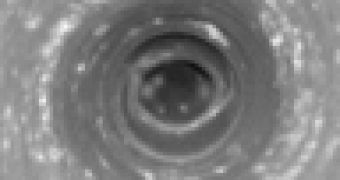The Cassini spacecraft around Saturn has now imaged the swirling hurricane-like vortex near the planet's South Pole. This is the first time such a storm with a well-developed eye ringed by towering clouds has been observed on another planet.
The frames of the movie have been aligned to make the planet appear stationary, while the Sun appears to revolve about the pole in a counterclockwise direction. Click on the movie to see a larger version of it. The storm is about approximately 8,000 kilometers (5,000 miles) across, which is considerably larger than a terrestrial hurricane.
The winds producing this swirling of the clouds are thought to blow at about 550 kilometers (350 miles) per hour. The clouds inside the dark, inner circle are lower than the surrounding clouds, which tower 30 to 75 kilometers (20 to 45 miles) above them and cast a shadow that follows the Sun. These numbers have been deduced from the width of the shadow and the height of the Sun above the local horizon.
The storm is two to five times greater than the tallest thunderstorms ever witnessed on Earth and two to five times the height of clouds surrounding the eye of a terrestrial hurricane. Such a height difference arises because Saturn's hydrogen-helium atmosphere is less dense at comparable pressures than Earth's atmosphere, and is therefore more distended in the vertical dimension.
"The winds decrease with height, and the atmosphere is sinking, compressing and heating over the South Pole," said Dr. Richard Achterberg, a member of Cassini's composite infrared spectrometer team at NASA's Goddard Spaceflight Center, Greenbelt, Md.
On Earth, the eye of a hurricane appears because moist air flows inward across the ocean's surface, rising vertically and releasing a load of precipitation around an interior circular region of descending air. On Saturn however, there is no ocean but just the thick atmosphere.
Scientists are still debating whether the mechanism for the formation of this storm on Saturn resembles the way hurricanes work on Earth. Other storms seen on gas giants, such as Jupiter's Great Red Spot, have no eye, no eye-wall and are relatively calm at the center.
This giant Saturnian storm also differs from hurricanes on Earth because it seems to be locked to the pole and does not drift around like terrestrial hurricanes.
"It looks like a hurricane, but it doesn't behave like a hurricane," said Dr. Andrew Ingersoll, a member of Cassini's imaging team at the California Institute of Technology, Pasadena. "Whatever it is, we're going to focus on the eye of this storm and find out why it's there."
The images were acquired over a period of 3 hours on Oct. 11, 2006, when Cassini was approximately 340,000 kilometers (210,000 miles) from Saturn. The original images are taken from an oblique view toward the pole, and have been reprojected on a screen from an angle to make the perspective directly over the South Pole.

 14 DAY TRIAL //
14 DAY TRIAL //